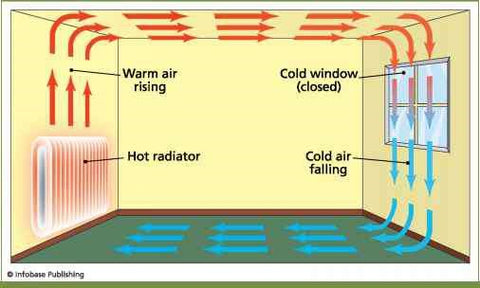
Cleaning Behind Radiators At Home
It could be that you've not even thought about what's lurking behind the back of the radiator, but just take a look behind as there's a good chance that what you see is years and years of accumulated dust – which is not good for your health!
Whoever thinks of looking behind their radiator on a regular basis? Indeed!
It's important to take the right measures and thoroughly clean behind the back of your radiators at least once a year and keep on top of any dust that builds up.
There’s dust in the air all the time, even now as you read this. It’s everywhere and it’s probably not all dust either – there’ll be pet dander,(if you have pets), nicotine residue (if you’re a smoker) and all sorts of other allergens mixed in – it’s probably best if you try not to think about it!!
Why Does Dust Gather Behind The Radiator?
The reason it gathers together and gets trapped behind your radiator is because of the heat convection process that influences air flow around your room!
Convection radiators circulate air which then causes dust to be circulated around the room. If you are allergic to dust, or other airborne particles the movement of the dust can aggravate the allergy.
Warm air rises and cool air falls so as the air continually recycles around the room and so takes dust with it and as it’s drawn up through the radiator, dust will then begin to collect at the back of your radiator!
Radiators can get extremely hot which means that the heat they emit provides the ideal temperature for bacteria to multiply and thrive in their millions.
Once someone touches your radiator and then touches another surface, contamination starts to spread through your home which can result in illnesses.
It's always recommended to turn off your heating before you even start to clean behind the radiator as a hot radiator stops the convection current recirculating the dust back into the atmosphere that is disturbed when cleaning!
There are many ways of cleaning behind your radiator – just make sure you put on those marigolds and cover your face with a dust mask before you start that laborious task of trying to get rid of all that dust accumulation!
Methods Of Cleaning A Radiator:
Vacuuming Behind The Radiator
The Vacuum cleaner with a hose is used to suck the dust from behind the radiator, BUT this still may not achieve the best result as it still cannot properly get to those hard to reach places which can still leave dust lingering behind the back of the radiator and on the wall.
Radiator Cleaning Brush
Some of you may you use the obvious the specialist radiator cleaning brush – but really is this the easiest way? In the meantime, don’t forget to put a towel or dust sheet under the radiator – to catch all the debris! Once that’s done get your brush down the back of that radiator and from top to bottom start pushing that dust and dirt right out back into the air that you breathe!!
Dropping The Radiator With A Radiator Removal Kit
To make it simple for you, you may consider making your radiators fully accessible to improve hygiene, ease of cleaning and for decorating.
The drop-down radiator removal kits can be fitted to most standard panel radiator, allowing radiators to pivot along with access of the radiator valves without putting any strain on the pipework or the fittings.
Cleaning behind radiators in the home will be beneficial for you and your family’s well-being during the winter months.
Conclusion
As it is vitally important to reduce dust levels circulating in the air that we breathe indoors to minimize the risk of Asthma attacks also home fever symptoms that we often mistake as winter chills or colds when we go to the Doctors that may be allergic reactions triggered by poor indoor air quality.
Did you know that Allergy UK estimates that at least 12 Million people are allergic to their own homes Dust particles contain VOC’s (Volatile Organic Components) and allergens that are known to be potent triggers of asthma attacks, allergies and respiratory infections?
By deep cleaning at least once a year before you use them in the Autumn season, as having radiators unused over the summer months causes large accumulations of dust - This improves the quality of air both you and your family breathe in which can reduce the symptoms of dust allergies and Asthma.


